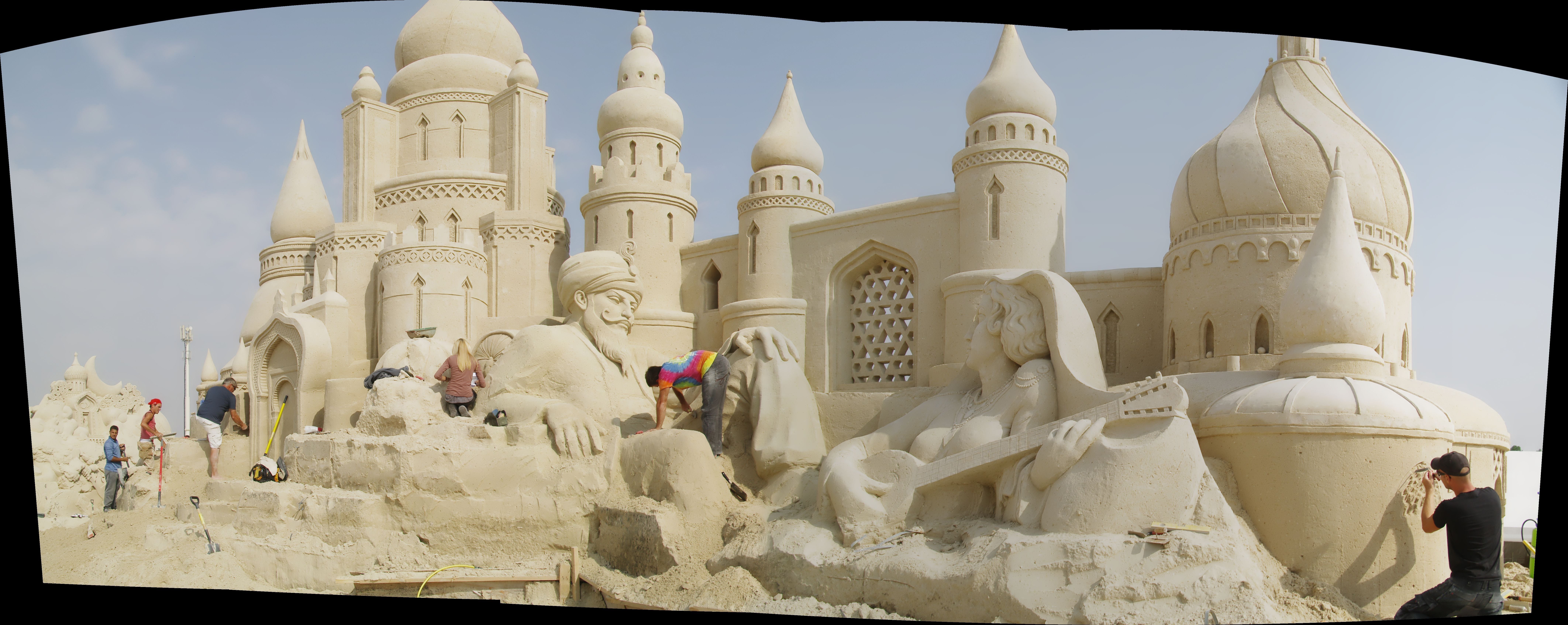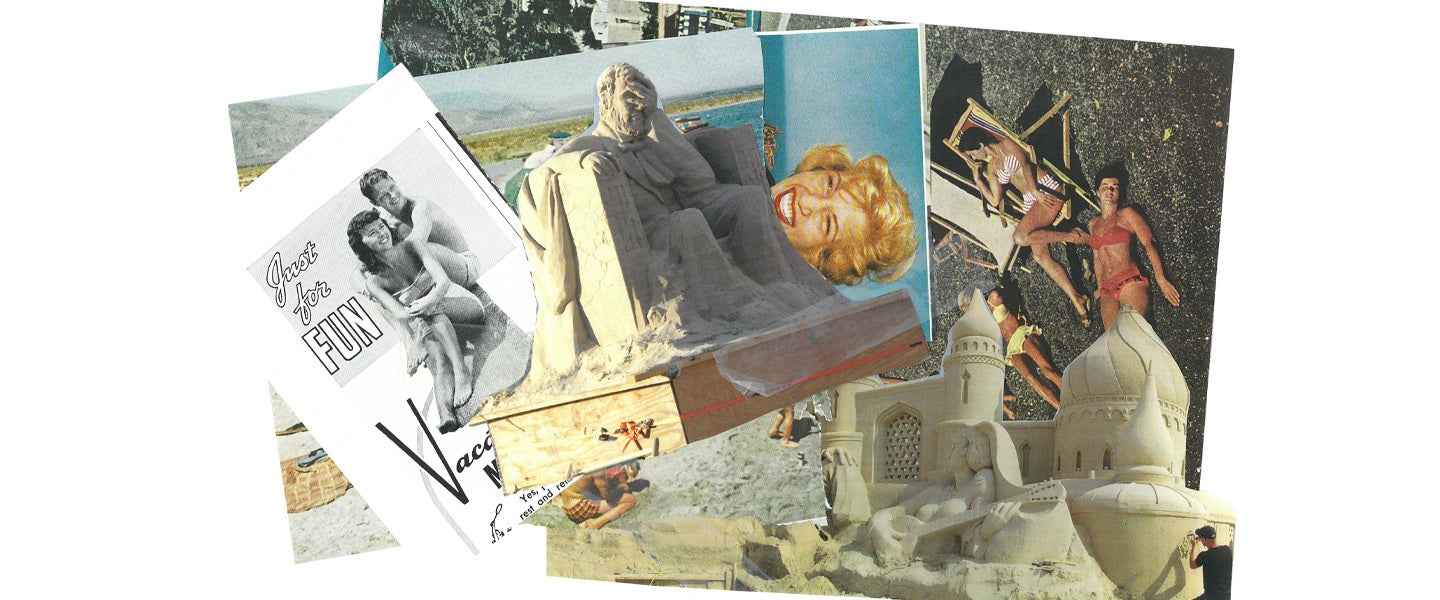At 28 years old, Emerson Schreiner is one of the youngest master sand sculptors — or, as they refer to themselves in the business, “sand people.” There are only a couple hundred professional sand sculptors left in the world, and the majority of them are in their 50s or older.
“I couldn’t tell you exactly why that is,” Schreiner tells MEL. “I would think it would be the type of thing that young people would flock to. Maybe it means I’ll get invited to more contests!” he adds. “Joking… sort of.”
Still, Schreiner remains optimistic that he’s not the last of dying breed. “I can’t imagine that this art dies out, though,” he says. “It’s way too alluring and way too much fun.”
My most burning question for Schreiner: Where, and how, does an aspiring sand person even start? How do you go from placing a twig at the top of an amorphous pile of sand to sculpting something like this?
Or this?
Or this?
I reached out to a few of the remaining master sand sculptors to see where they got their start, what their day-to-day is like, and how it feels to be so goddamn exfoliated.
It Started With a Steering Wheel
For the most part, sand sculpting is a lifelong pursuit. You don’t just start building a cool sandcastle on Venice Beach one day and enter a competition the next. Every sand sculptor I interviewed has a distinct memory of being hooked into sand sculpting as early as 5 years old — usually with the help of an artistic family member.
For example: Lucinda Wierenga, Schreiner’s aunt, is so well known in the sand sculpting business she has a pseudonym: “Sandy Feet.”
“I got really lucky in that she started getting me out on sand piles when I was really young,” Schreiner says. When he was 19, his aunt offered him an assistant job in South Padre Island, Texas, where she gave sandcastle lessons. “That really helped me learn a lot quickly,” he says. It “was when I started taking sand more seriously.”
Fred Dobbs, a 61-year-old professional sand sculptor from Canada, got his start when he was just 5 years old. He remembers the very moment that inspired him: “My father covered me waist-high, seated in sand, and began to sculpt me in a race car completely made of sand,” he says. “I was in the driver’s seat, [he] started sculpting a steering wheel, and so it began.”
Damon Langlois, champion of the 2019 Texas SandFest, got started when he was just 9 years old.
“The Pacific Northwest was a hotbed of modern-day sand sculpture,” he says. ”We have excellent beaches here, and like most people, I was drawn to playing with the sand. I was an artistic kid, so I would sculpt faces instead of castles.”
Eventually, Langlois, who worked as a designer, was invited by an officemate to join a sand-sculpting team called the SandBoxers. “With that team, I competed at these regional competitions and learned the ropes of sand sculpting,” he tells MEL, adding that now he considers sand sculpting his life-long passion.
“I don’t do it full-time like some of the others,” he says, “but I am a professional sculptor, competing at a master’s level and doing paid contracts for sand-sculpture projects around the world.”

World-record-holding master sculptor Ted Siebert, 61, discovered sculpting as a child through his father, an artist and college professor. On one vacation, his dad entered the family into a sand castle competition. “That was the first competition I’d ever gone to,” Siebert says. And while at the time, he says, he just kind of “pushed sand together, as kids do,” the “idea of being in team-oriented art competition” stuck with him.
Siebert gradually entered into more and more competitions. “They didn’t call ’em sand sculpting events, they were all ‘sand castle contests,’ so that’s how much it’s evolved in the last 35 to 40 years since then,” he explains. He remembers seeing the White Rock, Canada, sand castle world championships advertised in his favorite bar. “The first place prize was $5,000,” he tells MEL, “which I thought that was an insane amount of money to build a sand castle.” He ended up winning the contest. “It was just a blast to do,” Siebert says.
But Siebert discovered he could really make a living off his art while working part-time at a book publisher. “My boss asked what we did over the weekend, and I explained how we’d been entering and winning a lot of competitions. So he asked if we wanted to write a book on the subject.”
At the time, Siebert didn’t have a lot of experience writing, but after “diving into all the history, with photos from 1901 and all the [sand-sculpting] events in the country,” he completed and successfully published his first book, 1990’s The Art of Sandcastling. Siebert was thrilled to find it had a surprisingly wide audience. “The American Library Association picked up on it and said every library needed to carry it in the country… So that really helped launch my career, and it hasn’t slowed down in the 30 years since then.” Today, it’s “often referred to as the Bible of sand castling,” according to the Sand Sculpture Company.
Siebert calls himself fortunate. “It’s wild, always, when art pays the bills,” he marvels.
‘This Cute Little Thing on the Beach’
Despite making a living through their passion, sand sculpting isn’t the easiest life. Not only is it physically demanding work, but often the sculptors spend weeks crafting a monument out of sand only to rush to the next job before seeing people enjoy the final product.
“Oh it’s a full-time job and then some,” Siebert tells MEL. “I’m leaving for New Orleans, and then I have a job in Chicago, then Philadelphia, then something for the [Chicago] Blackhawks, then something for Rutgers Football… and then Malaysia Tourism wants a three-week-long job in December.”
“It’s more physical labor than many people realize,” Schreiner explains. “Your knees, neck and back are likely to get sore. It’s often many tons of sand that need to be moved and compacted manually. I don’t really mind all of that, though. It’s all worth it without a doubt.”
“Everybody thinks sand sculpting is this cute little thing on the beach, but we’re doing things that are the size of your garage, on average,” Siebert says. “There’s heavy machinery, we’ve got wires we work around to hold form together, and you’re dealing with 16-penny nails. I mean, I’m not kidding, it’s a construction project.”
Siebert says his hands and arms “get pretty gnarled up” from the wires, “but the worst is back problems, and you’ve gotta be mindful of the sun rays you’re being exposed to.”
“Gravity is our enemy, and the combination of sand, water and compaction is our secret weapon,” Langlois explains. “We might have to shovel ten tons of sand into forms and compact it with water in around six hours. It’s hard, physical, grueling work but it’s my favorite part. I love the pure physical nature of this part of the process and at the end there is this expression of potential energy that to me is quite beautiful.”
“But overall, it’s worth doing and I really enjoy it… unless it’s raining,” Siebert laughs.
‘I’ve Seen Grown Men Just Break Down in Tears’
“I’ve always likened [sand sculpting] to a pastry chef who would create a beautiful cake knowing full well that someone is going to eat the cake,” says Dobbs. “From the get-go, you accept the fate of your creation.”
“Being able to ‘let go’ is a really important lesson that sand teaches you,” Schreiner adds. “Nothing you make is going to last forever; sometimes it’s just a few hours, maybe a few days. I can’t honestly tell you if I’ve gotten better at that over the years or not… I guess I find that I don’t ‘hold onto things,’ so to speak, too much in my regular life as well. Whether or not this is because of my experience in sand, I’m not sure.”
As much as sand sculptors must accept that 100 percent of their hard work is going to be destroyed in the end, it’s still a gut-punch when everything falls apart.
“It’s still really difficult if something collapses while you’re still working on it. … I think every sand sculptor would agree with that,” Schreiner explains. “You go into it knowing it won’t last a long time, [but] it’s still really difficult if it falls down before you’re ready.”
“I could tell you horror stories about that,” Siebert tells MEL. “I’ve seen grown men just break down in tears because they see two weeks of work just gone. And you just try to, I don’t know… it’s just really tough sometimes. It doesn’t happen that often, but it’s bothersome, I’ll tell ya that.”
“In Texas a bulldozer comes and knocks them down a few days after the festival ends,” Langlois says. “There is a certain pleasure watching videos of that.” Plus, he adds, nothing is ever completely gone thanks to the internet. “Images of them live on, so it takes on a kind of second life online, long after the sand has crumbled.”
“It’s usually a very public form of art, and an extremely alluring one at that.”
Most other forms of art are created in a private studio, just the artist and their canvas. If they screw up, they can start again, free from public prodding. Sand sculpting is the opposite. Not only are they often exposed to the elements, they’re exposed to passersby.
“I get a lot of stupid questions. I’ve been asked what I do if it rains when I’m working inside,” Siebert laughs. Overall, he’s not bothered by people’s questions, but there is one thing he finds particularly aggravating.
Sand sculpting requires a sealer, Siebert explains. It doesn’t glue the sand together, it’s simply a diluted solution to spray on the completed sculpture that protects it from rain and weather. Siebert tries to keep the sealer a secret, lest people begin to form conspiracy theories about his work. “If people see that little tiny bottle of sealer, they’ll go, ‘That’s how they’re holding all that shit together,’ because that’s what people want to believe. They just think there’s some secret.”
Isn’t there, though? “The secret is I’ve done some 700 of these and you haven’t. And I’ve broken eight world records, so I think I know what I’m doing — and that goes for everyone in the profession,” he adds. “It’s just the sealer. It’s already been carved, but I still have to hide it because people won’t hear otherwise.”
“It’s usually a very public form of art, and an extremely alluring one at that,” Schreiner says. But above it all, “it’s really rewarding to see the crowd’s reaction to what you’ve made.”
At least for Langlois, the public reception is very much a part of the art form: “It’s about the act of doing it and sharing that moment with the people that come to watch.”

‘The Last Thing I Want to Do Is Go to the Beach on My Day Off’
Outside the physical and public demands slowly wearing down the sculptors, there is, of course, the sand.
“I do enjoy at the end of the season being able to sleep in a bed without sand, or not wake up with it already in my mouth,” Schreiner tells MEL. “The best is vacuuming out my car that one final time.”
Plus, he says, his two other hobbies are rock climbing and guitar playing, “both of which require and build calluses that sand mercilessly destroys.”
Besides extreme exfoliation, there’s some other shit they have to deal with — literally. On occasion, the beach turns into a giant litter box for feral cats. “I’m sure Fred [Dobbs] didn’t bring this up,” Siebert begins, “but Fred and I were doing a job for a cruise line, so we were on a certain Caribbean beach, and Fred got some weird disease that you don’t wanna know about. It’s like a worm that crawls into your skin.
“He had to take special pills to get rid of it, because there were so many damn feral cats on the island,” he says. “I’ve dealt with some weird-ass, almost [sewer-like] sand… It’s just nasty.”
For Siebert, making a living on the beach means “the last thing [he wants] to do” is go to the beach on his day off.
“Especially walking in loose sand,” he says. “That is at the top of my pet peeves in this business. Walking in loose sand all the time, it just sucks… So I avoid the beach at all costs.”
Siebert says he and his wife have the option of taking walks on the beach or on a very pretty road next to their lakehouse in Wisconsin. “I always want to go on the road and she wants to go on the beach,” he tells MEL. “And I’m like, ‘Laura, please, don’t make me walk on this shit anymore.’”
“I’m sorry I’m grumpy,” Siebert laughs, “but I’ve been doing this so long, you know.”
The Tribe of Sand People
According to Siebert, there is a group of 70 or so sand sculptors in America and Canada. They’ve been working together for decades.
“I’m 61, and there’s a whole slew of people exactly my age in this business,” Siebert explains. “And we’ve all known each other for 30 years — so it’s fun, we have great reunions.”
“The sand sculpting community is one of the kindest, most generous and funniest groups that I’ve ever been a part of,” Schreiner tells MEL.
Langlois, who met his wife while competing against an all-girl team she was on, says the greatest thing about sand sculpting “is belonging to the tribe of sand people.”
“They are hard-working people from all over the world, so your life is really opened up to all different perspectives and cultures as you create alongside the same people,” he adds. “I don’t think it’s patience that makes a professional sand sculptor, it’s perseverance. I think that is what defines the sand sculptor. We always finish, and a collapse puts you to the task. What do you do? After you wipe the tears away, you find your grit, pun intended, and you make something great out of it. If you can’t do that, you won’t be a sand sculptor.”
“I know just about 60 to 70 percent of everybody that’s in this business, and I get along with most,” Siebert says. “There’s some I just can’t stand, for personality clashes or this or that… but it’s a fun group. It’s really creative. When you get to work with really creative people, it’s hysterical. Some of the shenanigans are great when you get ahold of one another.”
A ‘Dying Craft’
According to Langlois, there are “really only a couple hundred professional sand sculptors around the globe,” and most of them are entering their twilight years. As such, the elder sculptors worry about the sport.
“It reminds me of what happened to carousel and horse carvers when plastic was invented,” Siebert explains. “You didn’t need horses carved out of wood anymore.”
“Fred [Dobbs] and I are exactly the same age, Damon [Langlois] is maybe 10 years younger,” Siebert continues. “It’s just such a weird and sad thing. It’s almost like if you wanna say millennials, for lack of a better word, just don’t have any interest in anything like that.”
“I would agree with Ted [Siebert],” Dobbs adds. “The field of sand sculptors has not been replenished with younger faces in recent years, and I would hazard a guess that the internet has captured the majority of creative minds.”
If not the internet, Siebert wonders if the decades of work it takes to get to their level scares younger sculptors away.
“I think some people are just intimidated because they can’t see themselves getting to that level,” He says. “It takes decades of work… but I can count on maybe one hand how many people are in their 30s or younger. Go to a competition, and you’ll notice almost all the sculptors are in their 50s or 60s.”
But Dobbs is optimistic. “I would like to add that over the years it has amazed me as to some of the skilled people who are drawn to sand sculpture: dentists, engineers, architects and carpenters, as well as formally trained academy sculptors,” he says. “For some, the lure is working with a simple medium, the potential for large-scale projects or being outdoors on the beach near the ocean.”
Like Dobbs discovered on an Irish beach in 1963, the beauty and power of sand sculpting will always be there, awaiting every little kid molding a race car with his dad.

